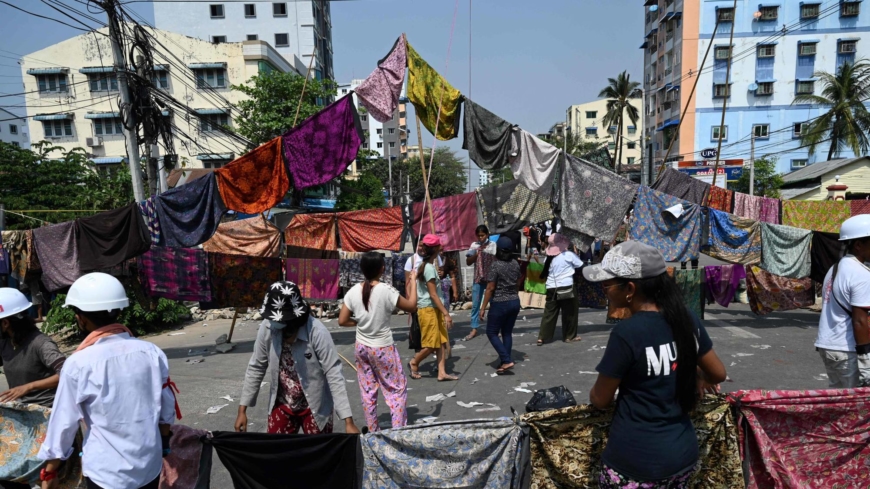[ad_1]
Yangon – Sarong-like cloths strung out on lines may seem innocuous, but long-held superstitions around women’s clothes appear to have stopped security forces in their tracks as they move to quell an uprising against Myanmar’s junta.
The country has been in uproar since the military ousted the civilian government and seized power on Feb. 1, triggering mass protests that the junta has sought to quash with increasingly lethal force.
They have used tear gas, stun grenades, rubber bullets and sometimes even live rounds against protesters, who are responding with imaginative tactics of their own.
The latest involves hanging women’s undergarments and long skirts — or longyis — on a clothesline across the street.
According to old Myanmar traditions, women’s lower parts and the garments that cover them can sap power — known as “hpone†— from men.
“If they go under a women’s longyi, that means their hpone is destroyed,†activist Thinzar Shunlei Yi said.
Some soldiers are unwilling to touch a women’s longyi for fear that it could hurt their chances on the front lines.

“When the community hang the longyi above the rope, (police and soldiers) can’t go in the streets, they can’t cross it, and they have to take it down,†said Thinzar Shunlei Yi.
Women are now wielding the superstition as a defensive strategy.
Swooping clotheslines of longyis and knickers have suddenly decorated Yangon, from the buzzing San Chaung township to the city’s rural outskirts, where pictures shared on Facebook showed a soldier standing atop a truck to remove one.
Some of the longyis also have images of junta leader Min Aung Hlaing’s face pasted on them, in a further superstitious ploy.
He features prominently on posters plastered onto the ground across the commercial hub — protesters believe it could slow security forces reluctant to step on his portrait.
Yangon has completely transformed since the coup.
Massive makeshift barricades are now commonplace, with communities stacking bricks, old tires, tables and barbed wire to prevent authorities from entering their districts.

Some neighborhoods descend into chaos daily as now-seasoned demonstrators take to the streets in defiance of truckloads of police and soldiers.
Plastic bags full of water — to help diminish the sting of tear gas in the air — are distributed in hot spots of unrest.
Designated people also carry buckets of water full of soaked blankets, ready to wrap them around gas canisters, while others hold mirrors as shields to confuse their attackers.
As they flee security forces bearing down on them, they release plumes from fire extinguishers to gain precious time — scattering to pre-arranged escape routes.
Even with all their ingenuity — thanks to some tactics borrowed from Hong Kong and Thailand’s pro-democracy movements — the field remains unequal, said Thinzar Shunlei Yi.
“We stay on our own principle, which is non-violence… we need to delay that violence to us to make sure we have less injuries from them.â€
Since the coup, more than 50 civilians have been killed, according to the U.N., with images showing security forces firing into crowds, leaving blood-covered bodies with bullet wounds in their heads.
One 19-year-old demonstrator, Kyal Sin, was shot dead in Mandalay on Wednesday, the bloodiest day since Feb. 1.
The junta has denied responsibility for loss of life in the protests, with state media on Friday saying “death cases due to small firearms are not associated with the security forces.â€
In a time of both misinformation and too much information, quality journalism is more crucial than ever.
By subscribing, you can help us get the story right.
KEYWORDS
[ad_2]
Source link





